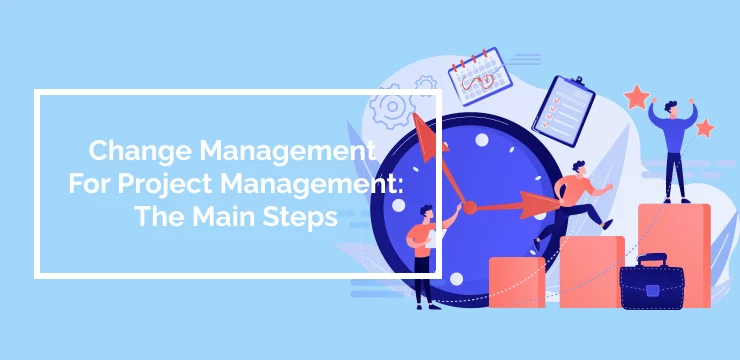
Project management and change management go hand-in-hand to ensure project success. As the project team executes the project, the change management team helps all affected users transition to the new way of doing things. Both are crucial to achieving the project objectives.
Integrating change management in project management reduces employee resistance and ensures you leave no one behind during the changes. Yet half of all change initiatives fail because of employee resistance and other reasons.
This guide covers the basics of change management to get you in the right direction.
What Is Change Management In Project Management?

Among other plans, a project management process includes a change management plan which controls the deliverables, budget, time, and quality. It outlines the process for managing change (i.e., who controls what, when, how), the tools, and change control activities (submitting change requests, reviewing, approving, documenting change impact, etc.).
It is a systematic approach to transitioning an organization’s goals, processes, or technologies. Change management implements strategies for effecting change, controlling change, and helping people adapt to change, with change managers typically working side by side with project managers.
Organizations can analyze a change’s impact through change management strategies and can also implement strategies to reduce the time to implement the change and support the employees.
Ultimately, change management at the project level helps achieve the expected benefits by supporting a person’s transition. Similarly, project management focuses on achieving the project’s goals.
What Are The Four Different Types Of Change Management?
We can categorize change management processes based on the types of change, including; anticipatory, reactive, incremental, and strategic change.
Anticipatory

Anticipatory changes are expected/planned changes to compete better in the future. For example, if a business is growing fast and needs to automate routine tasks, change managers will help the employees learn how to use the new system quickly and with minimal errors.
Reactive

Reactive changes are unexpected circumstances (e.g., a business collapsing because of war/political instability). The reactive approach often occurs when no one anticipated the incident leaving little or no time to curate a structured approach to handle it. This means that senior leaders must use the least amount of time to tackle obstacles.
Incremental

Incremental changes occur in small increments until you meet the organization’s intended goals. Since you roll out the changes gradually, it gives employees enough time to adjust and allows teams to gather feedback and make informed decisions throughout the change process.
Strategic

Strategic changes are more impactful and may affect overall organizational success — for example, a change in response to a market threat or opportunity. So top management is usually in charge of such changes.
Change Management For Project Management: The Main Steps

Below are what you need to do to manage organizational changes in project management.
Accept & Understand The Need For Change
What’s the change, why does it need to happen, and how will it happen? Understand the need for the change to communicate its benefits and implement it effectively.
Understand:
- Why does the organization need to change? – clear objectives that align with the project’s objectives
- How will the change benefit the organization?
- How will it affect how people work?
- What will people need to do to change successfully?
- How will the changes impact people positively?
Identify Stakeholders’ Needs
Stakeholders are the influential people in a project’s success. Each has a different perspective, skill, and pain point. So instead of a generic approach to every stakeholder’s needs, you need to dive deeper. What are their motivations? What do they want to see in the business? How will they measure success?
Examples of internal stakeholder groups include:
- Project sponsors
- Subject matter experts
- Business unit leaders
- Process owners
- Individual end-users
To identify the influential stakeholders, create a list of the groups affected by the change. Here are some questions to identify key stakeholders (all answers should be either yes or no):
- Does the stakeholder impact the business’s performance (profits)?
- Can you specify what you want from the stakeholder?
- Do you want the relationship to grow?
- Can you replace them easily?
Then for each stakeholder, answer these questions:
- How much influence do they have?
- What changes do they want to see?
- How will they measure the success of the changes?
Finally, interview each stakeholder to identify their interests, limitations, needs, and processes. That’s a stakeholder analysis. Analyze the data from the research to identify trends or conflicting interests. You’ll then group the stakeholders according to their requirements. If the stakeholders’ requirements don’t match the project’s core requirements, you may need to readjust or reevaluate the project’s direction.
Make Sure Roles & Responsibilities Are Clearly Defined
Prominent roles in change management include the change manager, change management process owner, and Change Advisory Board members. But depending on the organization structure, you could have a change submitter, change implementer, emergency Change Advisory Board, etc.
Here’s how to build your change management team.
The change management process owner will monitor the change process and review it at a high level to ensure it’s consistent with the organization’s overall strategy. They also ensure that the change manager has all the resources needed to implement the change. And they resolve any disputes in allocating responsibilities. They also provide the mission statement, strategy, roadmap, metrics, and process (including getting the process approved).
The change manager executes the change management process. They’ll coordinate the change activities to ensure they operate within the agreed process and integrate with other processes. They also set targets, review the efficiency of the change processes, conduct performance audits, and chair the Change Advisory Board. They report change management activities to top management. The change manager will steer the changing focus while the project manager steers the project focus in upper management meetings.
The Change Advisory Board members schedule, assess, and approve changes. Have members who understand the project’s technical and business viewpoint to ensure the change activities align with the technical, business, vendor, and customer viewpoints. They also review the change records for accuracy and advise the change manager on maintaining and improving the change process.
The change submitter will plan, initiate, and execute change requests. They’ll also create the change implementation plan and communicate the change status and results.
The change implementer implements the change requests they receive from the change submitter.
Build A Communication Plan That Keeps The Project On Its Toes
Establish a clear and straightforward communication plan to inform the affected people of where the organization is going and why, the changes that will happen, dates, and milestones. The communication plan will persuade stakeholders and employees to adopt the changes if the following three things are clear: what’s in it for them, why the change is important, and how it will happen.
To create a communication plan, consider:
- Which stakeholders have an interest in the change? And how much communication will each stakeholder group need?
- What’s the purpose/objective of each communication?
- What channels are appropriate for each stakeholder?
- Who is responsible for delivering the messages? What roles and responsibilities will people have, and how do you ensure that they’re effective and consistent
- What communication guidelines do we need?
- How will you assess and improve communications?
Here are the steps for creating a change communication plan:
- Define the communication objectives – what goals to achieve, how, by whom, and how to measure success
- Stakeholder analysis to profile your audiences – who they are, what they need and fear, and what motivates them. Then create audience segments, e.g., segment the people according to their needs.
- Create your key messages for each segment – the messages should show the changes, whom they’ll affect, why it’s necessary when the change will occur, and the activities. The messages should be clear, straightforward, authentic, and easy to understand.
- Determine the communication channels – emails, town halls, face-to-face meetings, intranet, forums, webinars, etc. Choose the channels that suit your audiences.
- Create resources to educate on the change – videos, fact sheets, FAQs, etc.
- Get leadership support – educate the leaders.
- Continue communicating throughout the changes and after.
Involve Employees In The Decision Making Process
Gathering the employees’ feedback before, during, and after the change process builds empathy, which is key to leading organizational change. Gartner found that involving employees in planning could increase a change initiative’s success by 12%.
Consider how a CEO involved employees at all levels in a European retail bank change initiative. The CEO created a top-level story and let the directors add chapters to the story. The directors added the chapters and asked their teams to add more details, including how the changes would impact them and their responsibilities. They did this five levels down to branch managers, ensuring that everyone knew their part in the upcoming changes.
And in the process, one director shared the concern that customers wanted faster services – which the branch staff responded by saying the document imagers caused delays. The employees ended up causing a practical and much-needed change because they felt involved in the organization’s strategy.
When creating a communication plan, first interview a sample of employees to determine whether they’re excited, frustrated, or frightened by the change. Then segment the employees.
Another CEO created audience personas based on key employee segments for their communication plan. They interviewed employees in each segment to reveal questions, beliefs, feelings, and concerns about the current business strategy. Then they designed communication using the information from the interviews. For example, excited employees were encouraged to motivate their unmotivated peers. The CEO also addressed revealed concerns publicly, which built the leadership’s credibility. Such interviews should continue during and after implementing the change to match messages to the employees’ moods.
Develop, Redevelop & Constantly Evolve Change Management Plans
A change management plan outlines the process for implementing change. It includes well-defined goals/objectives, a communication plan, a training plan, and mitigating resistance to change.
Here are the steps to create a change management plan:
- Assess the current state of the organization– readiness assessments, culture, capabilities, and past change initiatives
- Create realistic change goals, their metrics, and key performance indicators
- Design the plan – rely on past successes and failures, acknowledge and address resistance areas, and communicate the reason for the change
- Assign open-minded people to own the changes
- Execute and improve
After execution change management plan, keep gathering feedback and communicating with the key stakeholders to improve the plan.
For example, personalize the change plan to address each affected individual’s concerns. Will they still have a job after automating half of their tasks? What will they do with their free time? How will their roles change?
Implement, Execute & Enforce Change Management Plans
When implementing change, keep these tips in mind:
- Roll out the project incrementally – start with a pilot program, gather feedback and improve the subsequent phases
- Make and distribute a timeline for implementing the changes
- Change leaders should lead by example – embrace and embody the changes before anyone else
- Review the change process regularly to track progress, keep everyone informed of the progress and stay accountable
- Use data to make informed decisions
Tips for leading change:
- Be authentic throughout
- Be visible and engage actively with employees to support the changes
- Be inspirational – create a compelling future-state picture and vision
- Be inclusive – involve as many affected people as possible
- Be clear about expectations
- Be proactive to provide the right communication at the right time
- Reinforce success and celebrate wins
- Keep evolving
Evaluate & Assess Progress
We need to evaluate and assess change activities progress to improve constantly – whether in the activities, training, communication, technologies, or any other aspect of the changes. Typically, organizations evaluate change management against the project baseline (scope, cost, and schedule).
Some tools to evaluate change management progress in project management are change management surveys, employee satisfaction surveys, system usage reports, project KPI measurements, cost/risk/benefits analysis, flowcharts, and process maps
The typical metrics for measuring change are how much time the people take to adopt the changes, the number of people who adopt the changes, e.g., live users in an app, and how successful the employees are in their tasks after implementing change.
Organizations also measure whether the change management strategy is in line with the overall business strategy, the level of satisfaction with the communication and training efforts, and the level of comfort/frustration when using the new system.
Other metrics are organization performance after the change, compliance with the project plan, employee engagement, and stakeholder buy-in.
When evaluating your leadership in change management, think about where you improved communication, created more clarity, and upskilled people. For new hires or fires, how did it affect your team? And with all that, what can your team accomplish now? And how did you help them deliver their work? Also, consider the stakeholders. How did you support them? How did you improve the organization’s future with your decisions?
Get Started With Change Management At The Project Level
Project management and change management facilitate achieving a project’s success and organizational goals. The project leaders work with change leaders to achieve the project requirements while helping the people transition to the new processes.
Change management involves identifying stakeholders’ needs, helping them understand the changes, and evaluating the progress.
WalkMe Team
WalkMe spearheaded the Digital Adoption Platform (DAP) for associations to use the maximum capacity of their advanced resources. Utilizing man-made consciousness, AI, and context-oriented direction, WalkMe adds a powerful UI layer to raise the computerized proficiency, everything being equal.



